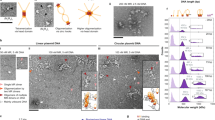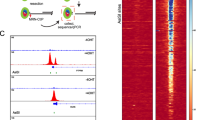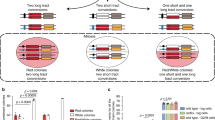Abstract
DNA double-strand breaks (DSBs) trigger activation of the ATM protein kinase, which coordinates cell-cycle arrest, DNA repair and apoptosis. We propose that ATM activation by DSBs occurs in two steps. First, dimeric ATM is recruited to damaged DNA and dissociates into monomers. The Mre11–Rad50–Nbs1 complex (MRN) facilitates this process by tethering DNA, thereby increasing the local concentration of damaged DNA. Notably, increasing the concentration of damaged DNA bypasses the requirement for MRN, and ATM monomers generated in the absence of MRN are not phosphorylated on Ser1981. Second, the ATM-binding domain of Nbs1 is required and sufficient to convert unphosphorylated ATM monomers into enzymatically active monomers in the absence of DNA. This model clarifies the mechanism of ATM activation in normal cells and explains the phenotype of cells from patients with ataxia telangiectasia–like disorder and Nijmegen breakage syndrome.
This is a preview of subscription content, access via your institution
Access options
Subscribe to this journal
Receive 12 print issues and online access
$189.00 per year
only $15.75 per issue
Buy this article
- Purchase on Springer Link
- Instant access to full article PDF
Prices may be subject to local taxes which are calculated during checkout




Similar content being viewed by others
References
Sancar, A., Lindsey-Boltz, L.A., Unsal-Kacmaz, K. & Linn, S. Molecular mechanisms of mammalian DNA repair and the DNA damage checkpoints. Annu. Rev. Biochem. 73, 39–85 (2004).
Bakkenist, C.J. & Kastan, M.B. DNA damage activates ATM through intermolecular autophosphorylation and dimer dissociation. Nature 421, 499–506 (2003).
D'Amours, D. & Jackson, S.P. The Mre11 complex: at the crossroads of DNA repair and checkpoint signalling. Nat. Rev. Mol. Cell Biol. 3, 317–327 (2002).
Lim, D.S. et al. ATM phosphorylates p95/nbs1 in an S-phase checkpoint pathway. Nature 404, 613–617 (2000).
Gatei, M. et al. ATM-dependent phosphorylation of nibrin in response to radiation exposure. Nat. Genet. 25, 115–119 (2000).
Falck, J., Petrini, J.H., Williams, B.R., Lukas, J. & Bartek, J. The DNA damage-dependent intra-S phase checkpoint is regulated by parallel pathways. Nat. Genet. 30, 290–294 (2002).
Yazdi, P.T. et al. SMC1 is a downstream effector in the ATM/NBS1 branch of the human S-phase checkpoint. Genes Dev. 16, 571–582 (2002).
Girard, P.M., Riballo, E., Begg, A.C., Waugh, A. & Jeggo, P.A. Nbs1 promotes ATM dependent phosphorylation events including those required for G1/S arrest. Oncogene 21, 4191–4199 (2002).
Lee, J.H. et al. Distinct functions of Nijmegen breakage syndrome in ataxia telangiectasia mutated-dependent responses to DNA damage. Mol. Cancer Res. 1, 674–681 (2003).
Uziel, T. et al. Requirement of the MRN complex for ATM activation by DNA damage. EMBO J. 22, 5612–5621 (2003).
Carson, C.T. et al. The Mre11 complex is required for ATM activation and the G2/M checkpoint. EMBO J. 22, 6610–6620 (2003).
Difilippantonio, S. et al. Role of Nbs1 in the activation of the Atm kinase revealed in humanized mouse models. Nat. Cell Biol. 7, 675–685 (2005).
Costanzo, V., Paull, T., Gottesman, M. & Gautier, J. Mre11 assembles linear DNA fragments into DNA damage signaling complexes. PLoS Biol. 2, E110 (2004).
You, Z., Chahwan, C., Bailis, J., Hunter, T. & Russell, P. ATM activation and its recruitment to damaged DNA require binding to the C terminus of Nbs1. Mol. Cell. Biol. 25, 5363–5379 (2005).
Mochan, T.A., Venere, M., DiTullio, R.A., Jr. & Halazonetis, T.D. 53BP1 and NFBD1/MDC1-Nbs1 function in parallel interacting pathways activating ataxia-telangiectasia mutated (ATM) in response to DNA damage. Cancer Res. 63, 8586–8591 (2003).
Lee, J.H. & Paull, T.T. ATM activation by DNA double-strand breaks through the Mre11-Rad50-Nbs1 complex. Science 308, 551–554 (2005).
Kim, J.S., Krasieva, T.B., LaMorte, V., Taylor, A.M. & Yokomori, K. Specific recruitment of human cohesin to laser-induced DNA damage. J. Biol. Chem. 277, 45149–45153 (2002).
Buscemi, G. et al. Activation of ATM and Chk2 kinases in relation to the amount of DNA strand breaks. Oncogene 23, 7691–7700 (2004).
Shiloh, Y. ATM and related protein kinases: safeguarding genome integrity. Nat. Rev. Cancer 3, 155–168 (2003).
Kitagawa, R., Bakkenist, C.J., McKinnon, P.J. & Kastan, M.B. Phosphorylation of SMC1 is a critical downstream event in the ATM-NBS1-BRCA1 pathway. Genes Dev. 18, 1423–1438 (2004).
Cerosaletti, K. & Concannon, P. Independent roles for nibrin and Mre11-Rad50 in the activation and function of Atm. J. Biol. Chem. 279, 38813–38819 (2004).
Horejsi, Z. et al. Distinct functional domains of Nbs1 modulate the timing and magnitude of ATM activation after low doses of ionizing radiation. Oncogene 23, 3122–3127 (2004).
Falck, J., Coates, J. & Jackson, S.P. Conserved modes of recruitment of ATM, ATR and DNA-PKcs to sites of DNA damage. Nature 434, 605–611 (2005).
Cerosaletti, K., Wright, J. & Concannon, P. Active role for nibrin in the kinetics of atm activation. Mol. Cell. Biol. 26, 1691–1699 (2006).
Lee, J.H. & Paull, T.T. Direct activation of the ATM protein kinase by the Mre11/Rad50/Nbs1 complex. Science 304, 93–96 (2004).
Costanzo, V. et al. Reconstitution of an ATM-dependent checkpoint that inhibits chromosomal DNA replication following DNA damage. Mol. Cell 6, 649–659 (2000).
Yoo, H.Y., Shevchenko, A., Shevchenko, A. & Dunphy, W.G. Mcm2 is a direct substrate of ATM and ATR during DNA damage and DNA replication checkpoint responses. J. Biol. Chem. 279, 53353–53364 (2004).
Van den Bosch, M., Bree, R.T. & Lowndes, N.F. The MRN complex: coordinating and mediating the response to broken chromosomes. EMBO Rep. 4, 844–849 (2003).
Moncalian, G. et al. The rad50 signature motif: essential to ATP binding and biological function. J. Mol. Biol. 335, 937–951 (2004).
Aten, J.A. et al. Dynamics of DNA double-strand breaks revealed by clustering of damaged chromosome domains. Science 303, 92–95 (2004).
Lisby, M. & Rothstein, R. DNA damage checkpoint and repair centers. Curr. Opin. Cell Biol. 16, 328–334 (2004).
Perry, J. & Kleckner, N. The ATRs, ATMs, and TORs are giant HEAT repeat proteins. Cell 112, 151–155 (2003).
De Lange, T. Shelterin: the protein complex that shapes and safeguards human telomeres. Genes Dev. 19, 2100–2110 (2005).
Lin, X.H. et al. Protein phosphatase 2A is required for the initiation of chromosomal DNA replication. Proc. Natl Acad. Sci. USA 95, 14693–14698 (1998).
Robertson, K., Hensey, C. & Gautier, J. Isolation and characterization of Xenopus ATM (X-ATM): expression, localization, and complex formation during oogenesis and early development. Oncogene 18, 7070–7079 (1999).
Friedland, W., Jacob, P., Paretzke, H.G., Merzagora, M. & Ottolenghi, A. Simulation of DNA fragment distributions after irradiation with photons. Radiat. Environ. Biophys. 38, 39–47 (1999).
Paull, T.T. & Gellert, M. The 3′ to 5′ exonuclease activity of Mre 11 facilitates repair of DNA double-strand breaks. Mol. Cell 1, 969–979 (1998).
Acknowledgements
We would like to thank W.G. Dunphy (Caltech) for the complementary DNA encoding ATM protein and T. Paull (University of Texas, Austin) for MRN baculoviruses. We are grateful to R. Baer and the members of Gautier laboratory for their suggestions and critical reading of the manuscript. This work was supported by US National Institutes of Health grant CA 92245 and National Cancer Institute contract N01-CN-25111 to J.G.
Author information
Authors and Affiliations
Corresponding author
Ethics declarations
Competing interests
The authors declare no competing financial interests.
Supplementary information
Supplementary Fig. 1
Mre11 binding to DNA is independent of H2AX assembly and phosphorylation (PDF 125 kb)
Supplementary Fig. 2
Phosphorylated and unphosphorylated Mre11 binds DNA (PDF 99 kb)
Supplementary Fig. 3
Monomeric and dimeric ATM binds DNA (PDF 61 kb)
Supplementary Fig. 4
Characterization of recombinant MRN complexes (PDF 114 kb)
Supplementary Fig. 5
Limit of detection of DNA purified from extracts (PDF 258 kb)
Rights and permissions
About this article
Cite this article
Dupré, A., Boyer-Chatenet, L. & Gautier, J. Two-step activation of ATM by DNA and the Mre11–Rad50–Nbs1 complex. Nat Struct Mol Biol 13, 451–457 (2006). https://doi.org/10.1038/nsmb1090
Received:
Accepted:
Published:
Issue Date:
DOI: https://doi.org/10.1038/nsmb1090
This article is cited by
-
Genome-wide CRISPR screen identified Rad18 as a determinant of doxorubicin sensitivity in osteosarcoma
Journal of Experimental & Clinical Cancer Research (2022)
-
New human ATM variants are able to regain ATM functions in ataxia telangiectasia disease
Cellular and Molecular Life Sciences (2022)
-
Structure-function analysis of TOPBP1’s role in ATR signaling using the DSB-mediated ATR activation in Xenopus egg extracts (DMAX) system
Scientific Reports (2021)
-
The activation mechanisms of master kinases in the DNA damage response
Genome Instability & Disease (2021)
-
3D culture conditions support Kaposi’s sarcoma herpesvirus (KSHV) maintenance and viral spread in endothelial cells
Journal of Molecular Medicine (2021)



